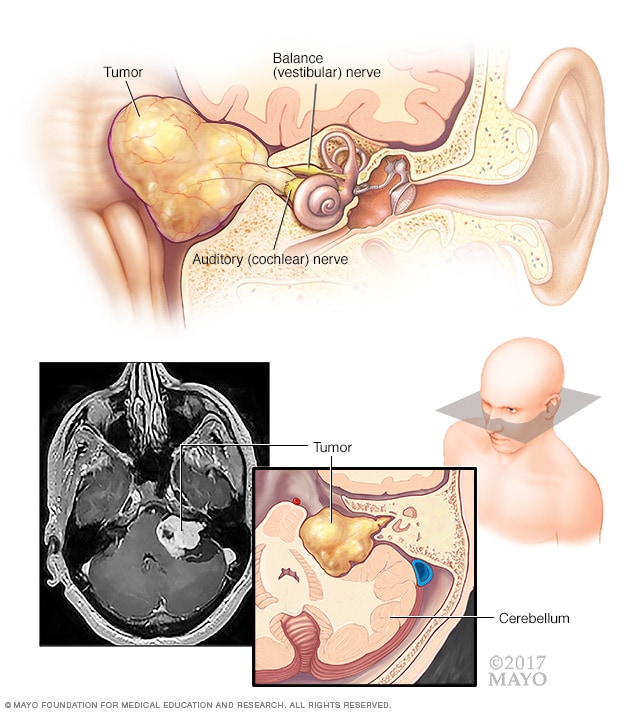Overview
Acoustic neuroma (vestibular schwannoma)

Acoustic neuroma (vestibular schwannoma)
An acoustic neuroma, also known as a vestibular schwannoma, is a noncancerous tumor. It develops on the balance nerve, known as the vestibular nerve, and on the auditory nerve, known as the cochlear nerve. These nerves lead from your inner ear to the brain, as shown in the top image. The pressure on the nerve from the tumor may cause hearing loss and imbalance. In some cases, the tumor may grow and affect the cerebellum or other brain tissues, as shown in the magnetic resonance imaging (MRI) scan and illustrations above.
An acoustic neuroma is a noncancerous tumor that develops on the main nerve leading from the inner ear to the brain. This nerve is called the vestibular nerve. Branches of the nerve directly affect balance and hearing. Pressure from an acoustic neuroma can cause hearing loss, ringing in the ear and problems with balance. Another name for an acoustic neuroma is vestibular schwannoma.
An acoustic neuroma develops from the Schwann cells covering the vestibular nerve. An acoustic neuroma is usually slow-growing. Rarely, it may grow quickly and become large enough to press against the brain and affect vital functions.
Treatments for an acoustic neuroma include monitoring, radiation and surgical removal.
Symptoms
Symptoms of an acoustic neuroma are often easy to miss and may take years to develop. Symptoms may occur because of the tumor's effects on the hearing and balance nerves. The tumor also can put pressure on nearby nerves controlling facial muscles, known as the facial nerve, and sensation, known as the trigeminal nerve. Blood vessels or brain structures also can be affected by an acoustic neuroma.
As the tumor grows, it may be more likely to cause more noticeable or worse symptoms.
Common symptoms of an acoustic neuroma include:
- Hearing loss, usually gradually over months to years. In rare cases, hearing loss can be sudden. Hearing loss usually occurs on one side or is worse on one side.
- Ringing in the affected ear, known as tinnitus.
- Loss of balance or not feeling steady.
- Dizziness.
- Facial numbness and, very rarely, weakness or loss of muscle movement.
Rarely, an acoustic neuroma may grow large enough to compress the brainstem and become life-threatening.
When to see your doctor
See a health care professional if you notice hearing loss in one ear, ringing in your ear or balance problems.
Early diagnosis of an acoustic neuroma may help keep the tumor from growing large enough to cause complications such as total hearing loss.
Causes
The cause of acoustic neuromas can sometimes be linked to a problem with a gene on chromosome 22. Typically, this gene produces a tumor suppressor protein that helps control the growth of Schwann cells covering the nerves.
Experts don't know what causes this problem with the gene. Often there is no known cause for an acoustic neuroma. This gene change is inherited in people with a rare disorder called neurofibromatosis type 2. People with neurofibromatosis type 2 usually have growth of tumors on the hearing and balance nerves on both sides of the head. These tumors are known as bilateral vestibular schwannomas.
Risk factors
Neurofibromatosis type 2
Autosomal dominant inheritance pattern

Autosomal dominant inheritance pattern
In an autosomal dominant disorder, the changed gene is a dominant gene. It's located on one of the nonsex chromosomes, called autosomes. Only one changed gene is needed for someone to be affected by this type of condition. A person with an autosomal dominant condition — in this example, the father — has a 50% chance of having an affected child with one changed gene and a 50% chance of having an unaffected child.
The only confirmed risk factor for acoustic neuromas is having a parent with the rare genetic disorder neurofibromatosis type 2. However, neurofibromatosis type 2 only accounts for about 5% of acoustic neuroma cases.
A hallmark characteristic of neurofibromatosis type 2 is noncancerous tumors on the balance nerves on both sides of the head. Tumors also may develop on other nerves.
Neurofibromatosis type 2 is known as an autosomal dominant disorder. This means that the gene related to the disorder can be passed to a child by just one parent. Each child of an affected parent has a 50-50 chance of inheriting it.
Complications
An acoustic neuroma may cause permanent complications, including:
- Hearing loss.
- Facial numbness and weakness.
- Balance problems.
- Ringing in the ear.
Large tumors may press on the brainstem, occasionally preventing the flow of cerebrospinal fluid between the brain and spinal cord. Fluid can build up in your head, a condition known as hydrocephalus. This increases the pressure inside the skull.